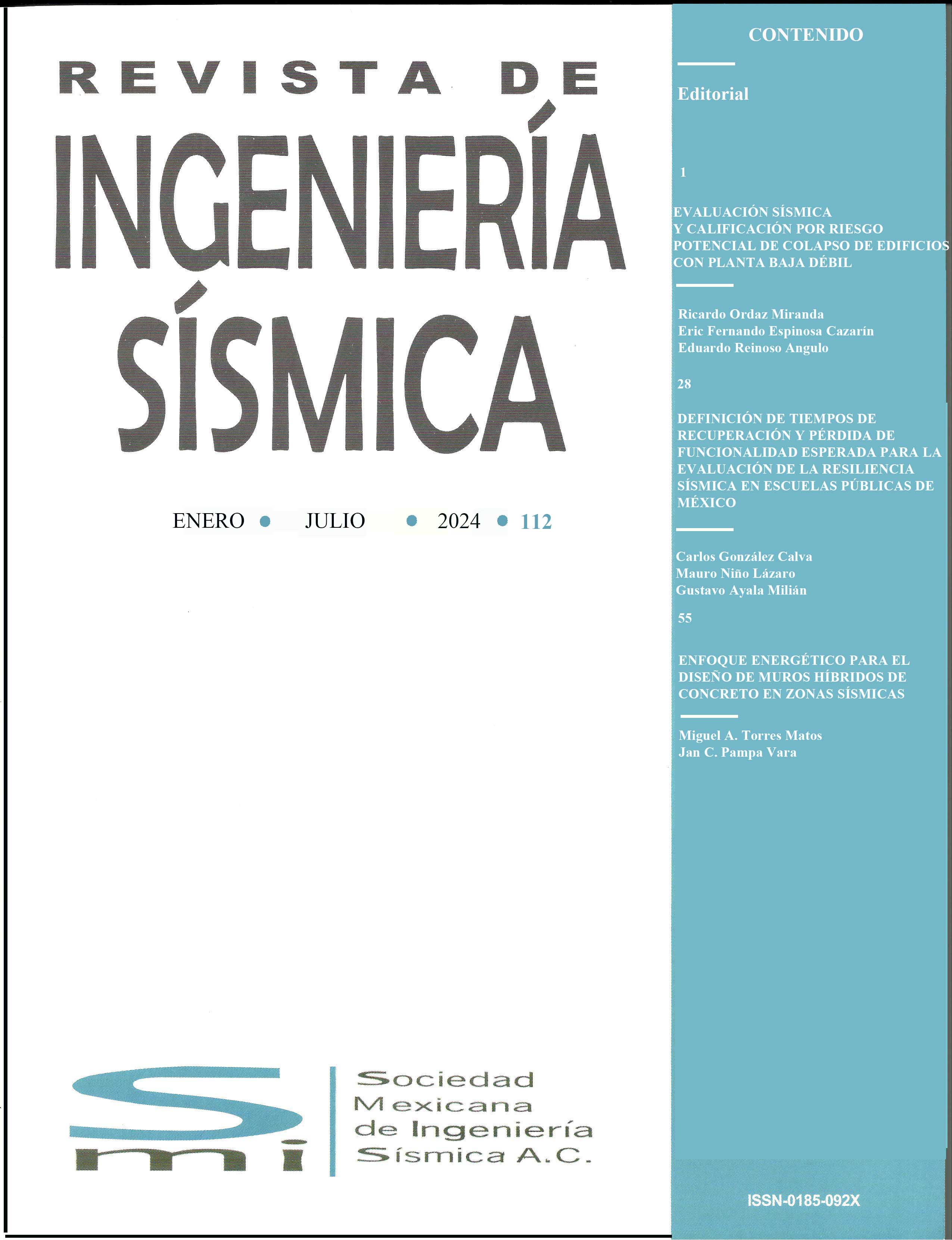ESTIMATION OF THE SEISMIC ACCIDENTAL-TORSION EFFECTS FROM THE AMPLIFICATION OF THE RESPONSE OF A TORSIONALLY BALANCED MODEL
DOI:
https://doi.org/10.18867/ris.103.490Keywords:
accidental torsion, accidental eccentricity, seismic design, seismic torsion, Monte Carlo simulationAbstract
Eight structural models representing 4, 7 and 10-level reinforced concrete frames are dynamically analyzed via Monte Carlo simulation and the Canny-E analysis program. The aim is to establish a simplified procedure to take into account the effects of the accidental torsion in the seismic design of buildings. The results show that it is possible to design a typical office frame building to withstand the accidental-torsion effects by using a simple relationship that amplifies the response of the corresponding torsionally balanced model to estimate the design forces and displacements.
Downloads
References
ASCE (2010). American Society of Civil Engineers Minimum design loads for buildings and other structures-ASCE. Standard 7-05: ASCE. EUA.
Associate Committee on the National Building Code (ACNBC). (1980). “National building code of Canada” (NBCC), National Research Council of Canada, Ottawa.
DANE. (2008). Estimación e interpretación del coeficiente de variación de la encuesta concensal. Colombia: Departamento Administrativo Nacional de Estadística.
De la Colina, J., y Benítez, B., (2006). Estudio probabilista sobre excentricidad accidental en edificios utilizando el método Monte Carlo. Puerto Vallarta, Jalisco: Sociedad Mexicana de Ingeniería Estructural, XV Congreso Nacional de Ingeniería Estructural.
De la Colina, J., González, C. y Valdés, J., (2016). Accidental eccentricities, frame shear forces and ductility demands of buildings with uncertainties of stiffness and live load: Engineering Structures 124, 113-127. DOI: 10.1016/j.engstruct.2016.06.012
De la Colina, J., Ruiz, S. y Benítez, B., (2011). Accidental eccentricity of story shear for low-rise office buildings: Journal of Structural Division, ASCE, 137 (4), 513- 520. DOI: 10.1061/(ASCE)ST.1943-541X.0000302
De la Llera, J. y Chopra, A., (1994). Accidental and natural torsion in earthquake response and design of buildings: Report No. UCB/EERC-94/07. Earthquake Engineering Research Center. University of California at Berkeley.
Díaz E., (1995). Selección del número de replicaciones en un estudio de simulación. Bilbao España: Departamento de econometría y estadística, Universidad del País Vasco.
ECS, (2004). ECS. Eurocode 8: design of structures for earthquake resistance. Part 1: general rules, seismic actions and rules for buildings. EN 1998-1:2004. Brussels Belgium: European Committee for Standardization.
Escobar S., A., Mendoza S., A. y Gómez M., R., (2002). “Procedimiento simplificado para diseño por torsión sísmica estática”. XIII Congreso Nacional de Ingeniería Estructural.
Escobar S., A., Mendoza S., A. y Gómez M., R., (2004). Diseño simplificado para diseño por torsión sísmica estática. Revista de Ingeniería Sísmica, Issue 70, pp. 77-107. DOI: https://doi.org/10.18867/ris.70.52
García D. V., (2015). Análisis de las probabilidades de excedencia de las respuestas de modelos estructurales con torsión sujetos a sismos usando simulación Monte Carlo. Toluca, Méx.: Tesis de Maestría UAEMex.
Hernández J., and López O. (2004). “Dependence of accidental torsion on structural system properties”. 13th World Conference on Earthquake Engineering, Vancouver, B.C., Canada. Paper No. 1165.
Hogg, S. y Craig, F., (1995). Introduction to mathematical statics. 5th ed. New Jersey: Prentice-Hall: s.n.
ICC, (2009). ICC. International building code. International Code Council: Inc.
Kang L. N., (1996). Canny-E User's Manual, Three-dimension nonlinear dynamic structural analysis computer program package: Canny Consultants Pte. Ldt., Singapur.
Metropolis, N; Ulam, S., (1949). The Monte Carlo method. Journal of the American Statistical Association, 44, 335-341. DOI:10.2307/2280232 https://www.jstor.org/stable/2280232
Nelson H. (2001). Influencia de la torsión accidental en el diseño sísmico de edificios. Tesis. Universidad nacional de ingeniería. Lima Perú.
Padilla, A., (2002). Evaluación de un requisito complementario a los criterios de diseño por torsión del RCDF en sus edificios 1995 y 2001: Tesis maestría, DEPFI, UNAM.
RC CdMx-2017, (2017). Reglamento de Construcciones para la Ciudad de México (RCDF) "Normas técnicas complementarias para diseño por sismo”.
Soriano, A. y Ruiz, S., (2001). Cargas vivas máximas para edificios de oficinas en la Ciudad de México: Reporte de investigación, Instituto de ingeniería UNAM.
Zárate, G., Ayala, A. G. y García, O., (2003). Método sísmico estático para edificios asimétricos: revisión de enfoques. Distrito Federal, Méx.: Revista de Ingeniería Sísmica, núm. 69, julio-diciembre, pp. 25-44. DOI:10.18867/ris.69.217






